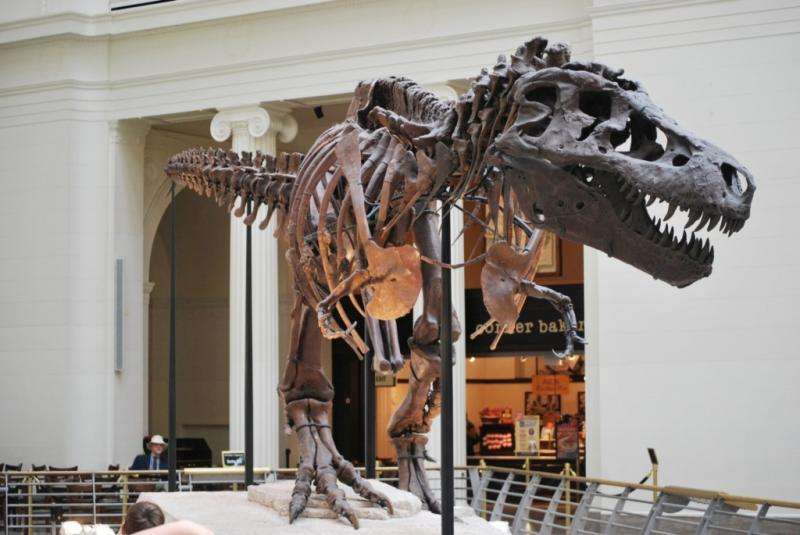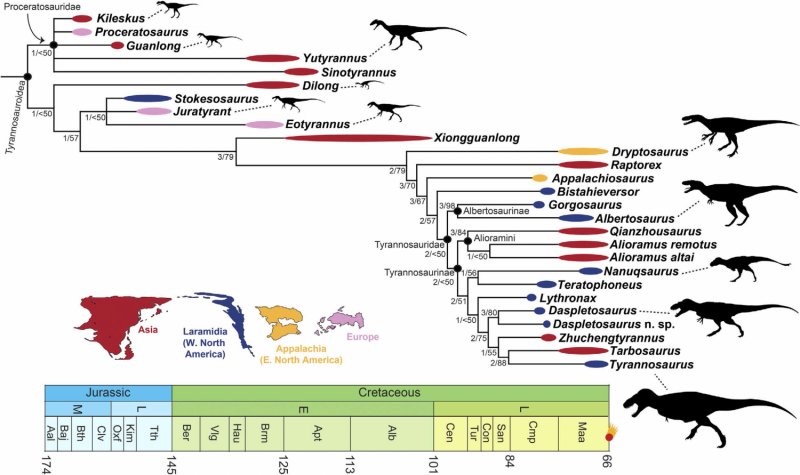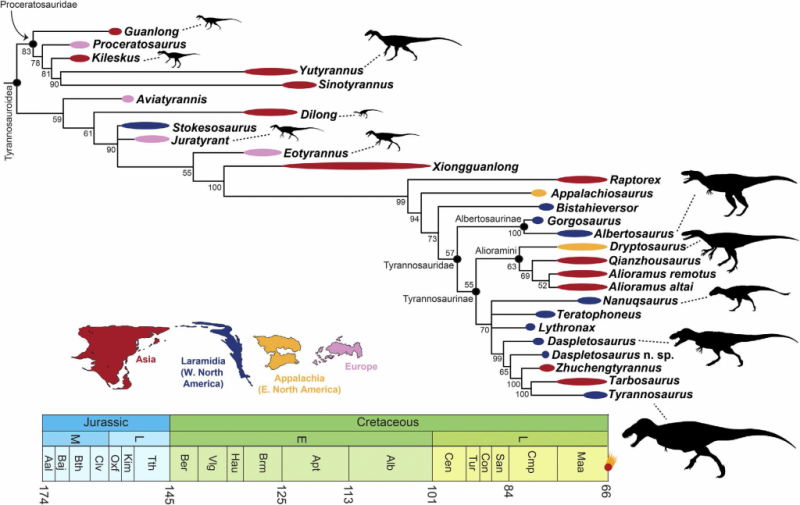What Animal Evolved From The T Rex

T. rex is probably the about notorious and infamous dinosaur of all time, and somewhat of an icon in both the scientific and public spheres. Afterward all, it was a pretty fearsome and impressive carnivore, and arguably worthy of such adoration. Just there were really a lot of other dinosaurs similar to T. rex, together forming a grouping known equally tyrannosauroids.
Recently, a whole series of new findings is helping u.s.a. to unlock the secrets of these fascinating beasts, and we can now brainstorm to answer questions well-nigh their evolutionary relationships, biogeography, and how decent their fossil record is. In fact, half of all known tyrannosauroid species have been discovered in the concluding decade alone!
Tyrannosauroid species were actually around way earlier T. king, which merely occupied the top of the food concatenation right at the end of the Cretaceous reign of the non-avian dinosaurs. Actually, the largest tyrannosauroids only seemed to announced effectually 20 meg years before this. Before they achieved such terrifyingly gigantic sizes, most were actually quite minor-bodied (for a dinosaur), and quite ecologically diverse.
Steve Brusatte, Thomas Carr and their colleagues visited the question of the inter-relationships of tyrannosauroids back in 2010. Forming hypotheses of relationships similar this forms the ground for assessing important evolutionary factors, such as the origins and development of particular anatomical features, rates of evolution, diversity, anatomical disparity, and biogeography. Then when some other report produced culling results to their earlier study, Brusatte and Carr decided to go back to the Mesozoic and reanalyse tyrannosauroids, but incorporating all of the recent bits of cognition we have gained well-nigh them over the terminal few years.

In addition to this, Brusatte and Carr decided to arroyo this with a dual method. Typically, when palaeontologists create trees that grade the basis of assessing evolutionary relationships, we use a method called parsimony. This looks at how many unlike anatomical changes accept occurred betwixt different species, and tries to provide the minimum number of changes in gild to build a tree. They also decided to go Bayesian on their dataset though, something which hasn't really taken off in palaeontology yet, and has been more widely applied to molecular analyses. This works slightly differently by analysing anatomical data (in the form of a character matrix) in a probabilistic framework, and by using more complicated models that treat characters in different ways. Past using this combination of techniques, it is possible to run across which results are congruent, and therefore which conclusions can be best supported.
Fortunately for Brusatte and Carr, the results of both analyses were quite similar overall, lending support to their conclusions. At that place are slight differences, which you can see by comparing the 2 trees figured here. The overall structure reveals that tyrannosauroids tin be sub-divided into a basal clade of proceratosauroids, which includes taxa such as the feathered Yutyrannus and Guanlong; an intermediate group or grade of pocket-sized- to medium-sized beasties; and the gigantic noon predators such every bit T. rex and Tarbosaurus that we all know thanks to the best scientific minds in Hollywood.
The authors do a great job of trying to work out why their results differ slightly, but equally always, the devil is in the details and information technology can exist quite hard to figure out. Part of the reason for some of the discrepancies might be to exercise with missing data – nosotros can never fully sample every organism that has lived, and palaeontologists accept that limit of the fossil record. In the case of tyrannosauroids, in that location is a 20 meg year gap in their fossil record from just before the time when the Western Interior Seaway covered much of Northward America. What this means is that animals merely weren't preserved in the right time in the right place to be preserved as fossils. Yet, at to the lowest degree. Discovering new tyrannosauroids from this gap might be critical in working out how more than derived tyrannosauroids evolved during a conspicuously of import fourth dimension in their history.

Only what does all of this hateful then for the evolution of tyrannosauroids? Well, for starters, information technology shows that the evolution of their large trunk size appeared to happen more gradually, rather than a rapid burst. Accompanying this, it shows that seize with teeth forces increased incrementally too, and that their elaborate facial ornamentations gradually became more complicated along with increasing trunk size. The first truly gigantic tyrannosauroids, coming in at more than 1.5 tonnes in mass and 10 metres in trunk length, didn't appear in the fossil record until around lxxx 1000000 years ago.
In terms of their biogeography, some interesting patterns sally. Information technology seems similar there was episodic interchange betwixt Asia and Due north America during the Belatedly Cretaceous. What this means, and I'm sure Donald Trump volition beloved this, is that T. rex actually appears to take been an Asian immigrant that colonised North America. Even so, this agreement might modify as we recover ever more tyrannosauroid fossils from the latest Cretaceous of Asia and North America.
So, that's a quick update on what we know virtually tyrannosauroids. Despite them clearly winning a cross-dinosaur popularity contest, at that place is still much nosotros tin can learn about these creatures, and only time and hereafter exploration tin tell what we'll detect!
More information: Marking A. Loewen et al. Tyrant Dinosaur Evolution Tracks the Rising and Fall of Late Cretaceous Oceans, PLoS ONE (2013). DOI: x.1371/periodical.pone.0079420
S. L. Brusatte et al. Tyrannosaur Paleobiology: New Enquiry on Ancient Exemplar Organisms, Scientific discipline (2010). DOI: x.1126/scientific discipline.1193304
Stephen L. Brusatte et al. The phylogeny and evolutionary history of tyrannosauroid dinosaurs, Scientific Reports (2016). DOI: 10.1038/srep20252
This story is republished courtesy of PLOS Blogs: blogs.plos.org.
Citation: The evolution of tyrannosaurs (2016, February xviii) retrieved 4 July 2022 from https://phys.org/news/2016-02-evolution-tyrannosaurs.html
This document is subject to copyright. Apart from any fair dealing for the purpose of private written report or research, no part may exist reproduced without the written permission. The content is provided for information purposes only.
Source: https://phys.org/news/2016-02-evolution-tyrannosaurs.html
Posted by: restercoorms.blogspot.com

0 Response to "What Animal Evolved From The T Rex"
Post a Comment